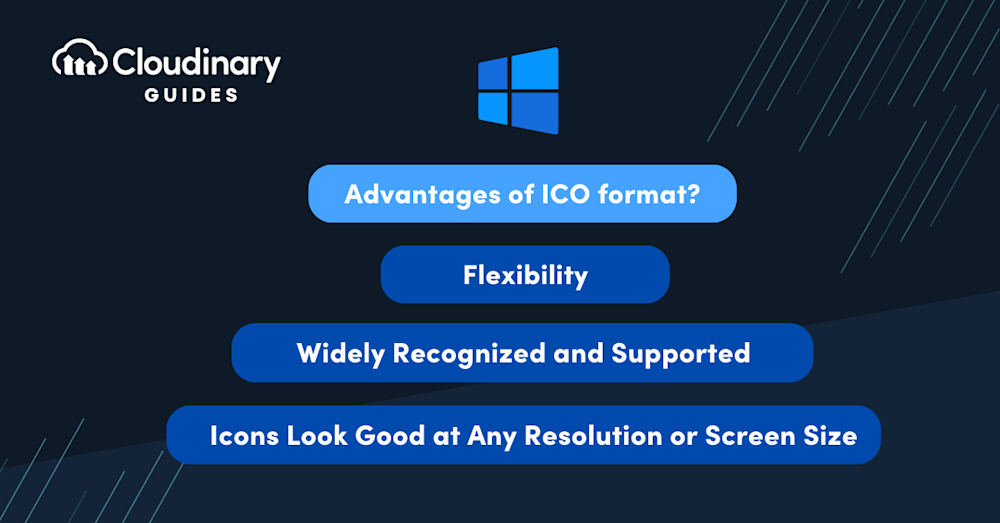What Is the ICO File Format?
An ICO is a type of image file format that is specifically designed for storing icons for Windows operating systems. These icons are typically used for representing applications, files, or directories on the computer.
ICO format files can contain multiple images of varying sizes and color depths, which makes it possible for the icons to be displayed optimally on different screen resolutions and settings. This unique feature is one of the reasons why ICO format is widely used and preferred for creating icons.
This is part of a series of articles about image formats
In this article:
- Who Developed the ICO File Format?
- Common Uses Of ICO File Format
- Advantages of ICO Format
- Disadvantages of ICO Format
- Limited Compatibility
- Limited Color Depth
- File Size
Who Developed the ICO File Format?
The ICO file format has its roots in the early days of the Windows operating system. It was developed by Microsoft and first introduced in Windows 1.0, which was released back in 1985. Over the years, the format has evolved along with the Windows operating system, incorporating new features and improvements to keep up with the changing requirements of the digital world.
Microsoft has continued to maintain and update the ICO file format, ensuring its compatibility with newer versions of the Windows operating system. The current version of the ICO format supports icons with varying dimensions, color depths, and transparency levels, making it a versatile choice for icon creation.
Common Uses Of ICO File Format
Website Favicons
One of the most common uses of ICO format is for website favicons. A favicon, short for “favorites icon,” is a small icon displayed next to a website’s URL in the address bar of a web browser. It also appears in browser tabs, bookmarks, and history lists, helping users identify and recognize the website easily. Using ICO format for favicons ensures that the icon looks crisp and clear, regardless of the browser or device being used to access the website.
Desktop Shortcuts
Another popular use of ICO format is for desktop shortcuts. When you create a shortcut to an application, file, or folder on your computer, an icon is displayed on the desktop to represent that shortcut. The ICO format ensures that these icons look sharp and professional, with the ability to scale to different sizes without losing quality. This makes it easier for users to identify and access their shortcuts quickly.
Application Icons
Application icons are crucial for creating a visually appealing and user-friendly interface. ICO format is widely used for creating icons for both Windows and third-party applications. These icons are used not only on the desktop but also in the Start menu, taskbar, and system tray. ICO files ensure that the application icons are displayed optimally on various screen resolutions, making it easier for users to recognize and launch the applications.
Advantages of the ICO Format
Flexibility of ICO Format
One of the key advantages of the ICO format is its flexibility. As mentioned earlier, ICO files can contain multiple images of different sizes and color depths. This means that a single ICO file can contain all the required icon versions for different screen resolutions and settings. This eliminates the need for multiple image files for each icon version, simplifying the icon management process.
Widely Recognized and Supported
The ICO format has been around for decades, which means that it is widely recognized and supported across various platforms and applications. This makes it easier to work with ICO files, as you don’t have to worry about compatibility issues.
In addition, most image editing software, such as Adobe Photoshop and GIMP, offer support for creating and editing ICO files, making it convenient for designers and developers to work with this format.
Icons Look Good at Any Resolution or Screen Size
Because the ICO format allows you to store multiple icon sizes and resolutions in a single file, it is easy to design icons for display on different devices and screen resolutions. With a single ICO file, you can ensure that your icon looks crisp and clear on all devices, without having to create separate image files for each size and resolution.
Disadvantages of using the ICO Format
Limited Compatibility
One of the main disadvantages of the ICO format is its limited compatibility with non-Windows platforms. The ICO format may not be fully compatible with other operating systems like macOS, Linux, or mobile platforms. This can make it challenging to use ICO files in cross-platform projects or applications.
Limited Color Depth
ICO format has a limited color depth compared to other image formats like PNG or JPEG. The maximum color depth supported by ICO format is 24-bit, which allows up to 16 million colors. While this is sufficient for most icon designs, it may not be enough for creating highly detailed or photorealistic icons. In such cases, designers may need to use other image formats with higher color depths.
File Size
ICO files tend to be larger in size compared to other image formats like PNG or JPEG. This is because ICO files can contain multiple images of different sizes and color depths, which increases the overall file size. While this may not be a significant issue for individual icons, it can become a concern when dealing with a large number of icons, as it can lead to increased storage requirements and longer loading times.
Working with ICO Format Images in Cloudinary
Despite the challenges posed by the limitations of ICO files, integrating Cloudinary into your projects can shed new light on their efficiency and versatility. The ICO format can evolve and adapt to meet your specific design needs, thanks to Cloudinary’s transformative features.
One of the key benefits offered by Cloudinary is Programmable Media, which enables you to apply manipulations such as resizing, cropping, and effects to your ICO files beyond their static restrictions. This enables the creation of multiple variations of the same icon, catering to diverse design requirements. Plus, Cloudinary’s seamless delivery, courtesy of its CDN partnerships, allows for a smooth display of files across various browser platforms and improved site load times.
In conclusion, Cloudinary addresses the inherent limitations of the ICO format while optimizing their use for expanding design possibilities and boosting site load performance. This comprehensive approach ensures a more efficient and customizable experience in working with ICO files, transforming them from simple, static icons into flexible, adaptable assets.
Interested in making your multimedia tasks a breeze? Try out Cloudinary today.

